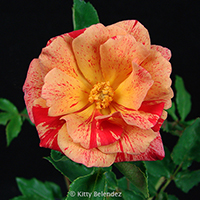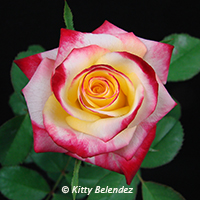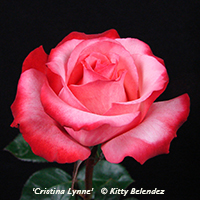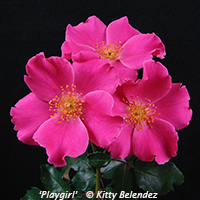Water and Roses
All day I faced the barren waste
without a taste of water.
Cool clear water.
The three most factors in real estate are said to be "location, location and location." These are important factors for roses as well, but the three most important factors in growing good roses are "water, water and water". Roses need water lots of water. When I am asked if there is but one thing a person can do to grow better roses, I will invariably say: "give them more water".
The importance of water in growing good roses is illustrated by the responses to a survey of the top national rose exhibitors which appeared in the Fall 1997 issue of Rose Exhibitors' Forum . The respondents were asked to rate the relative importance of 16 factors that have been mentioned as important in exhibiting roses. The overwhelming number one factor selected was "water". In fact, over half of the respondents listed "water" as the number one factor.
With the end of the rainy season. Los Angeles area rosarians now face the fact that the average rainfall for the six months May through October will total less than an inch. This means that rain will provide less than five gallons of water per large rose bush for the next six months. Given that studies show that a rose bush, depending on heat, will transpirate (give off) from 40 to over 100 gallons of water during the course of the summer, it is obvious that you cannot depend on the rain to give your roses the water they need. It is therefore a good time to consider how you plan to meet the basic need of the rose for water.
Wet Feet Worries
Gardeners with experience in over-watering house plants are often concerned about over-watering their roses. They become particularly concerned when they encounter the over-used rose expression "roses do not like wet feet". As a result, in a well-intentioned effort to keep the feet of their roses dry, they may fail to provide the rose with enough water.
The expression that roses do not like wet feet is a reference to the fact that roses require good drainage. Roses are not swamp plants and will not grow in standing water. The root system of the rose requires air in the soil to breathe, and standing water will actually drown a rose. The solution, however, to wet feet is not to avoid watering the rose. If the drainage is inadequate, it must be improved. If it is adequate, then there is no need for concern about the condition of the feet of your roses.
In these times of periodic water shortages, and given the cost of water, there is some small value in providing the rose with no more water than it might need. However, the answer to the question of how much water a rose may need is another of those "it depends" we encounter so often in rose growing. The amount of water needed depends on the weather, the size of the plant, the composition of the soil, the cycle of growth, the variety of the plant, and probably several other factors. As a consequence few of the available books on rose culture venture an opinion on exactly how much water a rose needs.
Roses need more water when it's hot and less when it's not. They require even less when it's raining and there is little to match the stupid feeling you get on a rainy night when you hear your automatic sprinklers come on. The humidity is also important here, as the rose will require more water at low humidity.
A mature, full-size hybrid tea in typical Los Angeles area soil requires about 6-9 gallons of water a week when the high temperatures are in the 70s. As temperatures rise into the 80s the rose will require about 9 gallons of water per week. In the 90s, the rose will require about 12 gallons per week and even more. A miniature rose, depending on size, requires about one-third to one-half as much. These figures are rough and based on the amount of water needed to maintain the highest level of show quality; the rose will stay alive on considerably less.
One gallon of water equals 231 cubic inches by volume. A typical full size rose in our area has a root zone with a diameter of about 30 inches. Using my calculator to figure out the pi times the radius squared etc., I have learned that 1-inch of water delivers about 3 gallons. So I deliver this amount 2-5 times a week depending on temperature. In adjusting this measure for containers and different size roses, I also keep in mind the radius squared business as this means that a rose with half the root diameter needs one-fourth the water.
Irrigation Systems
Since it rarely rains in Los Angeles during our rose growing season a sprinkler system is a must, preferably one operated on a timer. It is also best if the timer controls the water delivered to your roses separate from other parts of the garden. This is so you don't have to water your lawn or shady areas with as much water as you need for your roses.
It is my experience that pop-up sprinkler heads are the easiest and work just fine. Since we in the Los Angeles area have little blackspot and water-borne fungi, we can safely forget the business about not watering roses from overhead.
Some rosarians use drip irrigation systems, and I have done so in the past. I consider such systems to be tricky with roses since the emitters sooner or later clog and one often only discovers this when the rose begins to suffer from insufficient water. Drip systems also tend to deliver an uneven quantity of water to the rose. So I find it hard to become excited about them. Perhaps your experience will differ.
Figure Out How Much Water Your System Delivers
In order to determine how much water is actually being applied, it is helpful to do some testing to see how much water is delivered through your system, whether it is a hose, a sprinkler system, drip irrigation, or a watering can. You can measure your water pressure by timing how long it takes your hose to fill a measured container. I have found that water pressure varies throughout Pasadena and I am sure this is true elsewhere as well. My hose at full pressure delivers 12 gallons of water per minute so a slow count to five delivers a gallon. You can also measure your sprinkler output by placing a number of straight-sided cans or coffee mugs randomly in the rose garden. You should then run the system for 15 minutes and measure the amount in each cup. This will also help you to see where the water is being delivered and the uniformity of its output.
Local Water
The sources of water in the Los Angeles area vary somewhat from city to city, however a common source of most of the water is through the Metropolitan Water District. Pasadena's water, for example, is a blend of local wells, treated Arroyo stream water and purchased water from the Metropolitan Water District. Approximately 60% of Pasadena's water is purchased from the Metropolitan Water District, 30% is drawn from wells, and 10% is obtained from treated Arroyo stream and Eaton Canyon Wash water.
The water from the Metropolitan Water District is generally from river sources such as the Colorado River. River-source water, and water from local streams, is generally quite alkaline. The average pH of such water is approximately 8.2. By contrast Pasadena well water, having been filtered through the water table, has an average pH of 7.5.
The pH scale from 0 to 14 is used to determine the degree of acidity or alkalinity in a solution. A pH of 7 is considered neutral. The scale is logarithmic and each whole number represents a tenfold increase in acidity or alkalinity.
Roses do best in a soil with a pH at about 6.0 to 6.5. This is because important nutrients are most available to a rose at this level of acidity. Pasadena soil, like that in most of the L.A. area, is generally alkaline. Since its water averages a pH of 8.1, the water adds further to the alkalinity of the soil. It is therefore necessary to counter the effect of Pasadena's water through measures designed to acidify the soil.
Most fertilizers are highly acid and will assist in counteracting the effect of the water. However regular fertilization is not usually enough. Additional acidity can be obtained through annual treatment of the soil with soil sulfur.
A mulch is a covering of organic material spread or left on the ground around plants. Its primary purpose is to reduce evaporation and to hold water just below its surface where it can become available to rose roots. Roses tend to feed from feeder roots that are normally quite shallow. Mulch will keep the root zone cool and by conserving water and nutrients will stimulate the production of feeder roots.
The word "mulch" is derived from the adjective "melsh" meaning "soft". An ideal mulch will be soft and absorbent. This feature permits it to retain water and to prevent water run off. A soil with no blanket of mulch may become hard and compacted and may even become impervious to water.
An ideal mulch also adds important organic matter to the soil and contains valuable nutrients. It also activates the development of earthworms. Mulch also inhibits the growth of weeds and makes them easier to control. A good mulch is also decorative and adds a pleasing look to the garden.
Many organic products may be used for mulch. Ideally the material should allow good air circulation. It should be porous to allow water and fertilizer to pass through, pleasing to look at (and smell), and permanent enough not to blow or float away.
Commonly used mulching materials include redwood bark shavings, peat moss, compost, pine needles, wood chips, sawdust, and manure. It should be noted that sawdust and other wood products draw nitrogen from the soil in order to initiate their decomposition. It is therefore desirable to add some extra nitrogen for this purpose. Occasionally one will see garden with a white rock mulch which is thought to be decorative. A rock mulch, however, absorbs heat and radiates it up against the rose, an effect which is exactly opposite to the cooling effect sought from a good mulch.
I mulch with a commercial compost which I obtain in large quantity. I usually order about six yards (162 cubic feet) which makes a small mountain. In smaller quantities, mulches are typically sold by the cubic foot. A cubic foot is, of course, a cube measuring 12 inches on all sides. Assuming that your rose bushes are planted approximately 3 feet apart it can be assumed that the area around a bush to be mulched is about 8 square feet. Therefore 2 cubic feet of mulch applied 1" deep will be sufficient to mulch three roses bushes. A 2" deep layer will require twice as much. I usually apply the mulch at between 1-inch and 3-inches deep.
Conclusion
The weather is turning hot and the rains are gone until perhaps November. It is now time to pay some attention to the water requirements of your roses as the summer approaches. Give them lots of water and they they will reward you.
"Water, taken in moderation, cannot hurt anybody."
SEE RELATED ARTICLE: "The Right Amount of Water for Roses"
© Copyright Robert B. Martin, Jr. All rights reserved.
Photos © Copyright by Kitty Belendez
For questions about Santa Clarita Valley Rose Society, contact: Rose Society




